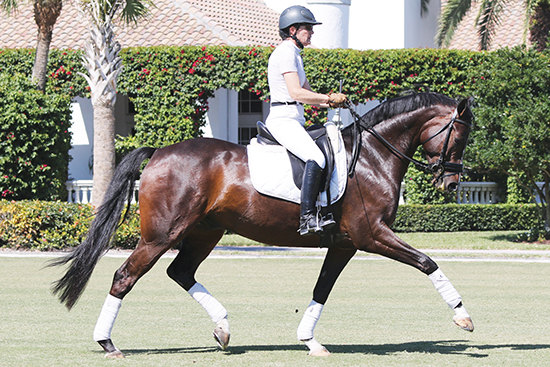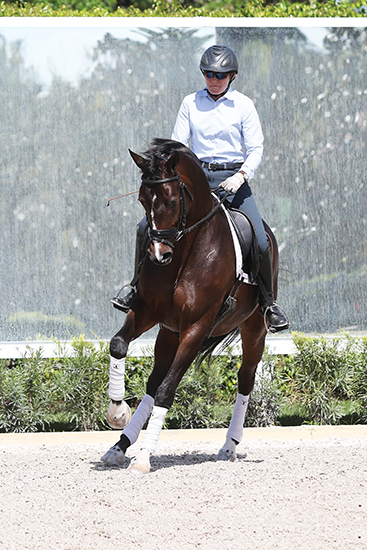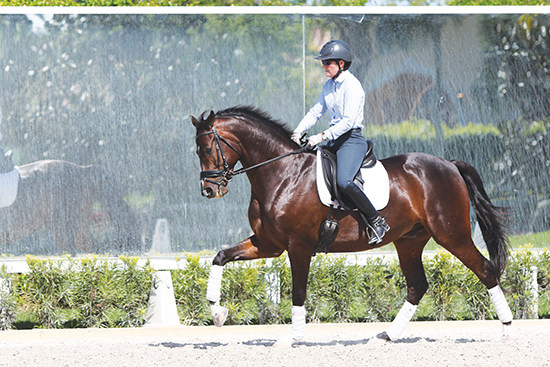 Words by Ilse Schwarz and Photos by Kenneth Braddick
Words by Ilse Schwarz and Photos by Kenneth Braddick
Over the past couple of months, we have presented a couple of fascinating articles by US based, Aussie dressage rider, Ilse Schwarz. Ilse, like the great jumping coach George Morris, lives in Florida, and George has been helping Ilse make the break-through to Grand Prix with her front-liner, Savignon. In this episode, George helps Ilse with a rather different horse…
I was lucky enough for George to find time in his schedule to give me a third lesson, this time on a six-year-old gelding who recently made the transition from the hunter/ jumper world to dressage.
The American sport of the hunter/jumper is truly difficult to explain. The horse must be good looking, jump in a soft manner, with no exuberance and the front legs must ‘dangle’ equally. To be honest, I really don’t understand it at all. However, it is a huge sport here and quite often, unsuccessful dressage horses shine in the hunter world. Occasionally the reverse is also true.
Monticello is by the Oldenburg stallion, Rosenthal out of a Thoroughbred mare that has produced some very good jumpers. He is absolutely stunning and was bought as a two-year-old by his current owners. He was unbeaten in his led classes at top breed shows and jumps in quite a competent manner for the hunter world, however, he really had no enthusiasm for it.
He is lucky to have owners who recognised this and they approached me about taking him as a sales horse. I get asked to assess quite a few hunters as dressage sales prospects, and in general, very few present as future FEI candidates. Monti is an absolute exception. Had I seen him going around the hunter ring, I would likely have sought out the owner and enquired about him.
The majority of our initial work was about developing acceptance of the bit and an understanding of the leg. In the hunter world, horses simply are not ridden from leg to hand. They are never really on a contact and certainly never learn how to carry on their hindlegs and become loose through the shoulders. The balance required for success in their world is quite different to that desired in the world of dressage! Nevertheless, Monti is a quick student and within months developed a good enough understanding of collection to be consistently scoring in the 70’s at elementary level.
Unfortunately, during his time as a hunter he learned how to do a perfect late-behind change. As his understanding of the reaction to the leg and hand aids has improved, I have been getting some clean changes on him. However, the session with GM presented the ideal opportunity to take a lesson on something that was still learning the changes. He is also a completely different ride to Savi, whereas she is hot to the leg, Monti certainly isn’t. He is the type that would prefer to push into the leg, rather than yield away from it, clearly a problem for the changes. I am eager to see where the lesson takes us.
George lets me warm up the horse the way I normally do. The owners of Monti, very successful hunter/jumper competitors, have come to watch the lesson, absolutely delighted that they get to watch George work with their horse, in a dressage arena!
Counter canter volte on the short side… pity my mirrors weren’t cleaned. They are normally spotless!
I move through warm up trot work with lateral work including shoulder in, leg yielding and travers and then some canter, GM explaining to the owners what each exercise is and why I am doing it. After some simple exercises we move to counter canter and I am instructed, on the short side, to make a big volte, still in counter canter, and then turn onto the diagonal and almost immediately as I straighten on the diagonal ask for a flying change. I am then to finish the diagonal, approach the next short side in counter canter, make a volte and then as straightening on the diagonal another change and so on.
“This exercise really gets the change from the leg. Just think inside leg and then after the change, half halt.”
So I come into each short side in balance. Monti is not immediately responsive to changes that truly only rely on the leg, so the canter gets a little big and wild, the change isn’t coming where I ask and it honestly gets pretty messy. The changes are clean though so, if nothing else, it has made it pretty clear how much Monti wants to push into the leg
We change the plan a little. I am now crossing the diagonal in true canter, aiming for a change over X, with George having very specific instructions for my legs.
Off the right lead, I am instructed to keep my left leg, the outside leg, on his ribcage but not back and then to ask for the change with simultaneous half halting on the right rein as the right leg goes back. Pretty standard aids for the change. Monti falls through my left leg and predictably, the change is late behind.
We try again.
“This time as you start the diagonal make him really straight. After making the horse straight, put the new inside leg (the left leg) forward. As you ask for the change with right rein and right leg moving back simultaneously, reinforce the aid of the left leg at the girth. If you keep the new inside leg too far back before the change, it is a chance for them to fall through that leg.”
As I co-ordinate the aids precisely, the changes come on the aids and clean.
“Don’t rush the change, first make the horse straight. As you approach the diagonal from the short side in right canter, the left leg is behind the girth because you have to make the horse straight but about one-to-two horse lengths onto the diagonal, the left leg moves forwards to the girth, the right rein engages and take the right leg behind.”
We then move to some exercises to make him more reactive and responsive to the leg aids. These are done in walk. We start with turn around the haunches, then turn around the forehand and finally, moving up and down the centreline, turns around the centre. Yes, first time I have done this also!
“Position the horse a little right and a half turn on the forehand with the left leg then walk forwards. Position the horse to the left and a turn on the forehand from the right leg.”
Counter canter clearly showing placement of the outside leg on the short side. When I turn onto the diagonal, THIS is the leg that George wants bought close to the girth, before asking for a change. Note the foot and stirrup iron correctly placed, yes, it is my left foot.
Since Monti falls through my left leg, it is an opportunity to make him aware of that leg in its role as an inside leg. These turns on the forehand are different to what we traditionally learn. Here, we are turning INTO the direction of bend rather than away from it. More difficult but it really brings a focus to the reaction from the inside leg.
“Now position the horse to the right and a half turn on the haunches right, straighten, continue down the centreline. Position the horse left and turn on the haunches left. If the horse is sticky in the turning, use the outside spur. Make the exercise clearly about the reaction to the leg.”
“Now, a turn around the centre. Position the horse to the right, turn the shoulder to the left and the haunch to the right so the axis of the turn is under your seat. Walk forwards and a half turn to the left. Position the horse left, bring his shoulders to the right and the haunch to the left.”
“These exercises get the horses, especially horses like this one who are a little dull to the leg, very light to the legs. Every problem in riding comes down to horses not being enough on the legs. The turn on the centre is the most powerful of the three turns because you are closing the shoulder to the haunch. You mobilise the shoulder and stir the haunch.”
It is time for a quick reminder for the rider, me, to quiet the hands again.
“Simply close the hand, you give the hand, you get too busy with the hand as is the fashion today.”
I promise you, I am working on being very quiet with my hands. He then has another word with me about my right foot slipping and sliding in the stirrup iron, I stare at it for a moment, internally direct bad words at it, and put it back in place.
“My pet peeve in my life is the stirrup iron. When it is not correct it is aesthetically not pleasing. I hate that. You can tell every student I have had because the stirrup iron is correctly placed.”
Yes. We really did finish the lessons on a discussion of foot placement in the stirrup. So, when I next see Mr Morris, likely towards the end of 2015, I plan to show him perfect feet in perfectly placed stirrups on whichever horse I am able to have a lesson with.
Oh yes, and Savi with her fifteen perfect flying changes as we head to big tour glory, she says, fingers firmly crossed…
This article first appeared in the October 2015 issue of THM.


